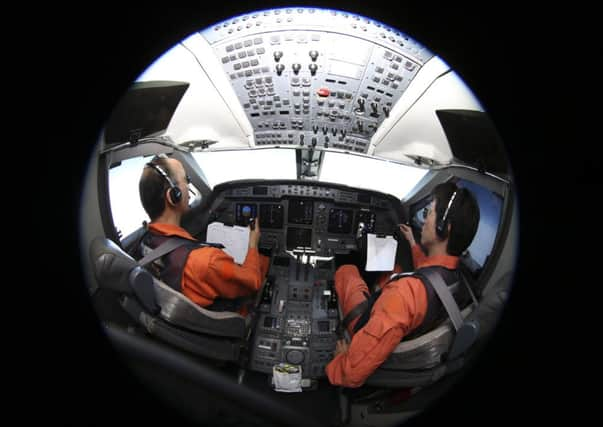Navy submarine joins search for jet’s black boxes


The Plymouth-based Trafalgar Class submarine HMS Tireless has arrived in the area – the focus of the search for the missing Boeing 777 – where it will help in the hunt for the plane’s flight recorders.
Amphibious survey vessel HMS Echo is also due to begin search efforts today.
Advertisement
Hide AdAdvertisement
Hide AdFlight MH370, bound for Beijing from Kuala Lumpur, disappeared on 8 March with 239 people on board, with a three-week search finding no sign of it.
The search area, which has repeatedly shifted as experts analyse radar and satellite data, is currently focused on a 98,000-square mile area off Perth, Australia.
Britain is also helping with technical assistance and specialist capabilities from across the Ministry of Defence, the Hydrographic Office, Department for Transport and the Met Office.
Four RAF personnel on secondment to the Royal Australian Air Force and Royal New Zealand Air Force are also actively involved in search operations.
A MoD spokesman said: “While we do not routinely comment on submarine operations, we can, exceptionally, confirm that HMS Tireless has been tasked to assist in the humanitarian search mission for Flight MH370.”
The search zone has moved from the seas off Vietnam to waters west of Malaysia and Indonesia, and then to several areas west of Australia.
The new development came as Australia, which is co-ordinating the search for the Boeing 777, cautioned that it “could drag on for a long time”.
Australia has deployed an airborne traffic controller over the Indian Ocean to prevent a mid-air collision among the many aircraft searching for the missing plane. An Australian Air Force E-7A Wedgetail equipped with advanced radar “is on its first operational” task in the search area in the middle of the Indian Ocean, the Australian Maritime Safety Authority said in a tweet.
Advertisement
Hide AdAdvertisement
Hide AdEarlier, Angus Houston, who heads the joint agency co-ordinating the multinational search effort, said the modified Boeing 737 will monitor the increasingly crowded skies over the remote search zone.
Eleven planes and nine ships are focusing on less than half of the search zone, 46,000 square miles of ocean west of Perth, with poor weather and low visibility forecast, according to the new joint agency co-ordination centre. A map from the centre showed that the search area was about 1,200 miles west of Perth.
Some of the aircraft have been dropping as low as 200ft above the water – and occasionally dipping even lower for brief periods – raising concerns of collisions with ships in the zone.
The arrival of the E-7A “will assist us with deconflicting the airspace in the search area”, Mr Houston told reporters in Perth.
Mr Houston, a former Australian defence chief, called the search effort the most challenging one he has seen.
“In this particular case, the last known position was a long, long way from where the aircraft appears to have gone,” he said. “It’s very complex, very demanding.
“What we really need now is to find debris, wreckage from the aircraft. This could drag on for a long time.”
Australian prime minister Tony Abbott has said that although the search for the aircraft has been slow, difficult and frustrating, it will continue indefinitely. He said the intensity and magnitude of operations “is increasing, not decreasing”, and added: “If this mystery is solvable, we will solve it.”
International Air Transport Association director general Tony Tyler said there is “disbelief” that flight MH370 “could simply disappear” and a plane must “never again go missing in this way”.